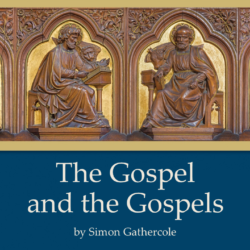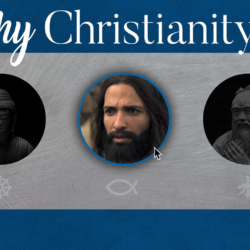Apologetics 9: Old Testament Transmission
What reasons do we have for believing the Old Testament (Hebrew Bible) was reliable transmitted from antiquity to today? This lecture provides four arguments: (1) Jewish scribes were competent, (2) people memorized large portions of the text, (3) the consequences for false prophecy, and (4) the Dead Sea Scrolls function as a time capsule. The Old Testament is excellently preserved, especially in comparison to other ancient texts.
If you would like to take this class for credit, please contact the Atlanta Bible College so you can register and do the necessary work for a grade.
Notes:
Introduction
- Circular reasoning: Why do you believe that there is a God->the Bible says so->How do you know that the Bible is true?->God wrote it
- This is the fundamental question of Christianity: “Anyone who knows the content of the Bible knows that its reliability is the single most important question in the history of humanity.” (Can You Trust the Bible by Ralph Muncaster, p. 4)
- Remember 1Peter 3.15
- Question:=>Too many translations, how do you know which is right? The Bible was written in Greek, translated to Aramaic then to Latin then to German and then to English.
Answer:=>We have more than 5,000 manuscripts extant today and there are several million people who speak the original language. We do not depend on a translation. (Pass around the Hebrew and Greek Bibles)
a. OT written in Hebrew
b. NT written in Greek
OT Manuscript Tradition
- manuscripts (hand written)
- Hebrew
- Aleppo Codex (a.d. 920)
- Leningrad Codex (a.d. 1009)
- Dead Sea Scrolls (250 b.c. to a.d. 70)
- early translations
- Aramaic
- Targum (5th c. a.d.)
- Samaritan
- Samaritan Pentateuch (11th c. a.d.)
- Syriac
- Peshitta (5th c. a.d.)
- Greek
- Septuagint (fragments from 2nd c. bc, complete from 4th c. a.d.)
- Theodotion, Aquilla, Symachus (before 3rd c.) (extant?)
- Coptic
- Crosby-Schoyen Codex (3/4th c. a.d.)
- Latin
- Codex Amiatinus (5th c. a.d.)
- critical editions
- Biblia Hebraica Stuttgartensia
- based mostly on Leningrad Codex but with variants from other sources as well
- last updated1997
- Biblia Hebraica Quinta
- incorporates Dead Sea Scrolls
- 20 volumes
- partially published since 2004, to be completed in 2015
- Oxford Hebrew Bible Project
- extensive critical edition underway at Berkeley, California
- Biblia Hebraica Stuttgartensia
Scribal Argument
- Only master scrolls were used for duplication
- Scribes were highly trained (noble profession)
- Held in training until age 30
- Ceremonial washing before copying Scripture
- Any time the name of God was written a sanctification prayer was said. (6,824 times in the NASB)
- Memorization was a problem so they visually confirmed the letters one by one
- Each letter was counted and compared to master
- Each word was counted and compared to master
- The middle letter in each scroll was located and compared to the master
- If there is one mistake, the scroll was discarded
- Scrolls are buried ceremonial when they wear out
Memorization argument
- Object Lesson: driving laws
- What do you do when school bus stops and you are driving towards it?
- What do you do at a stop sign? Yield sign? Green, yellow, & red lights?
- What do you do at a four way stop?
- What is the cell phone law?
- Why do you have all of these things memorized? Because it’s the law!
- Israelites memorized enormous portions of the OT. They had to; it was the law of the land. Furthermore, education was heavily based on memorization (Deut 6.4-9; 11.18-21; Psalm 78.5-7).
- “If anyone attempted to change Scripture; it would require changing not only a vast number of written copies but the memory of hundreds of thousands of people.” A Skeptics Search for God by Ralph Muncaster, page 138.
The seriousness of the prophetic office
- Rules about prophets (Deuteronomy 18.14, 20-22)
- If a prophet prophesied and it did not happen, then they would have been killed and their work would not have survived. Most of the prophets have short-term prophecies (which serve to authenticate) and longer prophecies (some of which are unfulfilled to this day). (Jeremiah 25.9-13; 27.1-7; 28.1-17)
The Dead Sea Scrolls: the ultimate time capsule
- The fragments comprise roughly 850 distinct documents
- 30% are fragments of Hebrew Bible (Old Testament)
- Genesis (18+3?), Exodus (8), Leviticus (17), Numbers (12), Deuteronomy (31 + 3?), Joshua (2), Judges (3), Samuel (4), Kings (3), Isaiah (22), Jeremiah (6), Ezekiel (7), Twelve (10 + 1?), Psalms (39 + 2?), Proverbs (2), Job (4), Song of Solomon (4), Ruth (4), Lamentations (4), Ecclesiastes (3), Esther (0), Daniel (8 + 1?), Ezra-Nehemiah (1), Chronicles (1)
- 25% are traditional Jewish religious texts (Enoch, Levi, etc.)
- 30% are biblical commentaries or community relevant writings
- 15% are still unidentified
- 30% are fragments of Hebrew Bible (Old Testament)
- read from Meister’s book, p. 131 (last paragraph)
- Discovered between 1947 and 1956
- show pictures of DSS: http://www.facsimile-editions.com/en/ds/
- The Dead Sea Scrolls prove that the scribal argument is valid.
- Romans 3.1-2, Jews are entrusted with the oracles of God
- A complete copy of the book of Isaiah was discovered
- It compared with only the slightest variations to modern copies (nothing that changed the meaning of the text)
- F. Bruce said of this discovery: “The new evidence confirms what we had already good reason to believe—that the Jewish scribes of the early Christian centuries copied and recopied the text of the Hebrew Bible with the utmost fidelity.”






